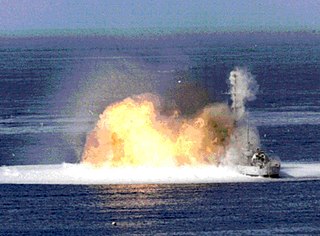
A thermobaric weapon, also called an aerosol bomb, or a vacuum bomb, is a type of explosive munition that works by dispersing an aerosol cloud of gas, liquid or powdered explosive. The fuel is usually a single compound, rather than a mixture of multiple molecules. Many types of thermobaric weapons can be fitted to hand-held launchers, and can also be launched from airplanes.

The RPO-A Shmel is a man-portable, single-use, rocket-assisted thermobaric weapon. While its name directly translates to flamethrower, the RPO-A Shmel is more accurately described as a thermobaric weapon. The Shmel is designed, produced and exported by the Russian Federation and previously by the Soviet Union. It entered service with the Soviet Armed Forces at the end of the 1980s as the successor for the RPO Rys.

The RPG-26 Aglen is a disposable anti-tank rocket-propelled grenade (RPG) launcher developed by the Soviet Union. It fires a one-stage rocket with jack-knife fins, which unfold after launch. The rocket carries a 72.5-millimetre (2.85 in) diameter high-explosive anti-tank (HEAT) single shaped charge warhead able to penetrate 440 millimetres (17 in) of armour, 1 metre of reinforced concrete or 1.5 metres of brickwork. It has a maximum effective range of around 250 metres (820 ft). The similar sized rocket features a slightly heavier and more powerful HEAT warhead and more powerful rocket engine. The limited extension of the RPG-22 launch tube was found of little use. Thus, the RPG-26 has a rigid non-telescoping launch tube.
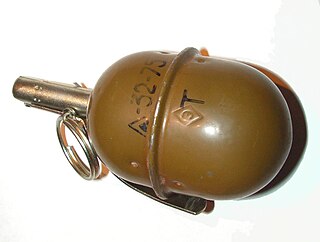
The RGD-5 is a post–World War II Soviet anti-personnel fragmentation grenade, designed in the early 1950s. The RGD-5 was accepted into service with the Soviet Army in 1954. It was widely exported, and is still in service with many armies in the Middle East and the former Soviet bloc.

The RGO hand grenade is a defensive Soviet fragmentation hand grenade introduced mid 1980s alongside the RGN during the Soviet-Afghan War to replace the earlier F-1, RG-42, and RGD-5 hand grenades, which proved to be inadequate in the mountains of Afghanistan.

The RGN hand grenade is an offensive Soviet blast hand grenade introduced during the Soviet-Afghan war alongside the RGO to replace the earlier F-1, RG-42, and RGD-5 hand grenades which proved to be inadequate in the mountainous terrain of Afghanistan.
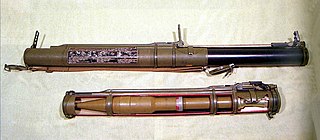
The RPG-18 Mukha is a Soviet short-range, disposable light anti-tank rocket launcher designed in 1972. It was based on the M72 LAW.
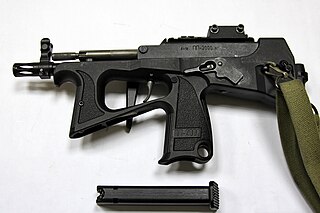
The PP-2000 is a submachine gun/machine pistol made by the KBP Instrument Design Bureau. It was first publicly displayed at the Interpolytech-2004 exhibition in Moscow even though its patent was filed in 2001 and issued in 2003.

The BMPT "Terminator" is an armored fighting vehicle (AFV), designed and manufactured by the Russian company Uralvagonzavod. This vehicle was designed for supporting tanks and other AFVs in urban areas. The BMPT is unofficially named the "Terminator" by the manufacturers. It is heavily armed and armored to survive in urban combat. The AFV is armed with four 9M120 Ataka missile launchers, two 30 mm 2A42 autocannons, two AG-17D grenade launchers, and one coaxial 7.62 mm PKTM machine gun.

JSC Konstruktorskoe Buro Priborostroeniya (KBP) is one of the main enterprises in the field of Russian defense industry, based in Tula. It is engaged in designing high-precision weapon systems for the Army, the VMF and the VKS, as well as anti-air defense systems, high-rate-of-fire cannons and small arms, in addition to civilian products. Its full name goes as "Joint-Stock Company Instrument Design Bureau named after Academic A. G. Shipunov". Its shareholders include High Precision Systems, part of the State Corporation Rostec.

The Shipunov 2A42 is a Soviet/Russian 30 mm autocannon. It is built by the Tulamashzavod Joint Stock Company and named after A. G. Shipunov.

Hermes is a family of modularly designed guided missiles developed in Russia by the KBP Instrument Design Bureau.
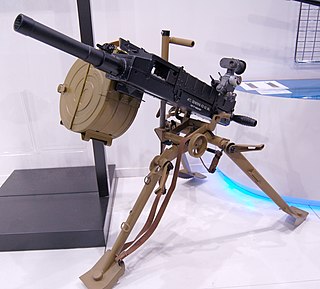
The AGS-30 is a Russian automatic grenade launcher currently in production in Russia and in service with the Russian armed forces.

The RGM-40 Kastet grenade launcher is a stand-alone version of the Russian GP-30 grenade launcher with a telescoping stock, AK-type pistol-grip and flip-up tangent sights. It is a single-shot muzzle loaded weapon with a self-cocking trigger mechanism and offers a high degree of commonality with the GP-30. It was designed primarily for police use and can use a wide range non-lethal ammunition. It can also use standard 40mm VOG-25 and VOG-25P fragmentation grenades.
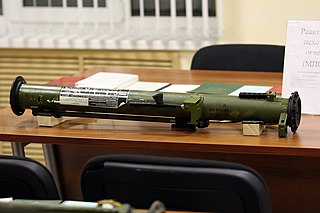
The MRO Borodach is a Russian self-contained, disposable single shot 72.5 mm rocket launcher.

Kitolov, shells are Russian laser-guided mortar and howitzer shells with the Malakhit automated artillery fire control system, which is able to attack stationary and moving targets with a top attack mode. The 120 mm (4.7 in) mortar shell is called Kitolov-2, the 122 mm (4.8 in) howitzer shell Kitolov-2M, and the 152 mm (6.0 in) howitzer shell Krasnopol-M2 Several mortars using this system can fire simultaneously without interfering with each other, and the system is using common data for targets spaced at up to 300 m (330 yd).
Jonathan Steven Ferguson is a British firearm historian and author who is currently the Keeper of Firearms and Artillery at the Royal Armouries Museum in Leeds, England. He is also a technical specialist with Armament Research Services, a consultancy firm.
Armament Research Services (ARES) is a consultancy company providing expertise and analyses in the field of arms and munitions to governments and non-government organizations. As of January 2014 director of Armament Research Services is N.R. Jenzen-Jones.

















